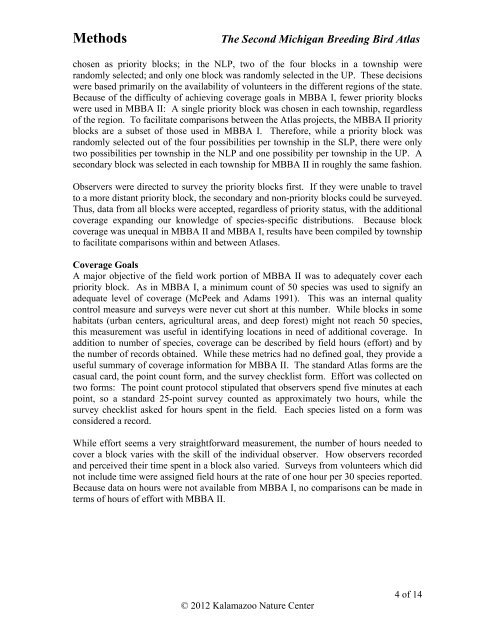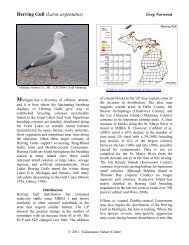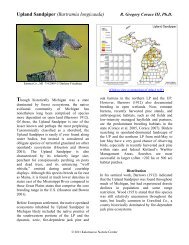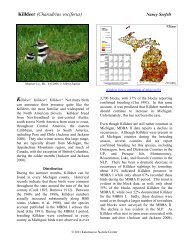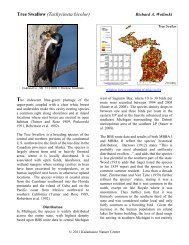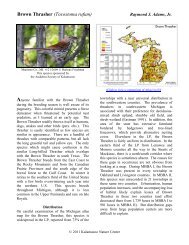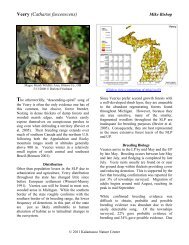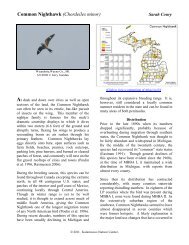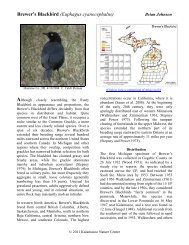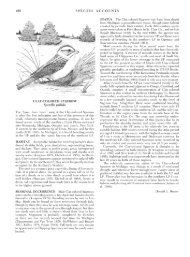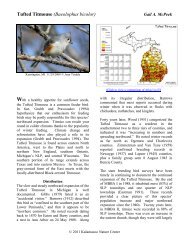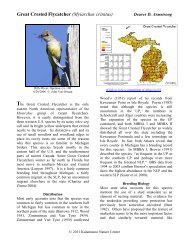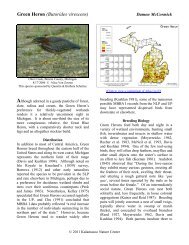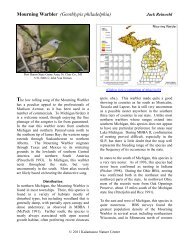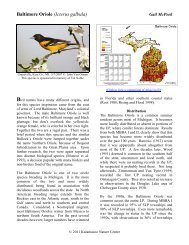Methods - Michigan Breeding Bird Atlas Website
Methods - Michigan Breeding Bird Atlas Website
Methods - Michigan Breeding Bird Atlas Website
You also want an ePaper? Increase the reach of your titles
YUMPU automatically turns print PDFs into web optimized ePapers that Google loves.
<strong>Methods</strong><br />
The Second <strong>Michigan</strong> <strong>Breeding</strong> <strong>Bird</strong> <strong>Atlas</strong><br />
chosen as priority blocks; in the NLP, two of the four blocks in a township were<br />
randomly selected; and only one block was randomly selected in the UP. These decisions<br />
were based primarily on the availability of volunteers in the different regions of the state.<br />
Because of the difficulty of achieving coverage goals in MBBA I, fewer priority blocks<br />
were used in MBBA II: A single priority block was chosen in each township, regardless<br />
of the region. To facilitate comparisons between the <strong>Atlas</strong> projects, the MBBA II priority<br />
blocks are a subset of those used in MBBA I. Therefore, while a priority block was<br />
randomly selected out of the four possibilities per township in the SLP, there were only<br />
two possibilities per township in the NLP and one possibility per township in the UP. A<br />
secondary block was selected in each township for MBBA II in roughly the same fashion.<br />
Observers were directed to survey the priority blocks first. If they were unable to travel<br />
to a more distant priority block, the secondary and non-priority blocks could be surveyed.<br />
Thus, data from all blocks were accepted, regardless of priority status, with the additional<br />
coverage expanding our knowledge of species-specific distributions. Because block<br />
coverage was unequal in MBBA II and MBBA I, results have been compiled by township<br />
to facilitate comparisons within and between <strong>Atlas</strong>es.<br />
Coverage Goals<br />
A major objective of the field work portion of MBBA II was to adequately cover each<br />
priority block. As in MBBA I, a minimum count of 50 species was used to signify an<br />
adequate level of coverage (McPeek and Adams 1991). This was an internal quality<br />
control measure and surveys were never cut short at this number. While blocks in some<br />
habitats (urban centers, agricultural areas, and deep forest) might not reach 50 species,<br />
this measurement was useful in identifying locations in need of additional coverage. In<br />
addition to number of species, coverage can be described by field hours (effort) and by<br />
the number of records obtained. While these metrics had no defined goal, they provide a<br />
useful summary of coverage information for MBBA II. The standard <strong>Atlas</strong> forms are the<br />
casual card, the point count form, and the survey checklist form. Effort was collected on<br />
two forms: The point count protocol stipulated that observers spend five minutes at each<br />
point, so a standard 25-point survey counted as approximately two hours, while the<br />
survey checklist asked for hours spent in the field. Each species listed on a form was<br />
considered a record.<br />
While effort seems a very straightforward measurement, the number of hours needed to<br />
cover a block varies with the skill of the individual observer. How observers recorded<br />
and perceived their time spent in a block also varied. Surveys from volunteers which did<br />
not include time were assigned field hours at the rate of one hour per 30 species reported.<br />
Because data on hours were not available from MBBA I, no comparisons can be made in<br />
terms of hours of effort with MBBA II.<br />
© 2012 Kalamazoo Nature Center<br />
4 of 14


